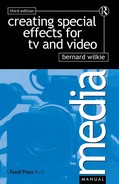Periscopes
Mirrors used in the devices outlined below should be surface-silvered on ¼ in polished plate glass. Ordinary mirrors not only give a double image, but the thinner glass distorts when fixed in a frame.
Periscope
Bulky TV and movie cameras can seldom be mounted low enough to obtain a ‘worm’s-eye view’. For this sort of shot a periscope must be used. Mounted in front of the lens it can lower the apparent viewpoint to a few inches above floor level. Clamped firmly to the camera it can be moved around to give a variety of tracking, panning and even zoom shots. Simple wooden or metal constructions suffice as long as the mirrors and their mountings are free of vibration.
Underwater periscope
A version of the periscope can be used to obtain underwater shots. This is particularly useful where models are being filmed under water, but where no camera diving-bell or observation windows exist.
Again, the periscope may be constructed of wood or metal, but all joints must be treated with a waterproofing compound. The lower mirror port must be covered with a sheet of plate glass to prevent water entering the periscope and the whole construction must be weighted to counteract the buoyancy of the internal air.
Underwater lighting
Underwater scenes must be illuminated and if a waterproof lamp is not available, the periscope described above can be used to beam light down from the floor above the studio tank to a point below the water level.
Snorkel shots
New types of lenses have been developed to capture extraordinarily close-up pictures of insects. Used to record certain special effects they can achieve results which would be unattainable from conventional optics. The eye-line of a dragonfly as it skims across the surface of a lake could be typical of the use to which these lenses are put.
But, of course, they are not simply supplementary attachments screwed to the fronts of cameras; they transmit their pictures via a series of tiny mirrors and lenses enclosed in long metal periscopes. The cameras themselves (which must be vibration-proof) are carried on large iron rigs which travel on heavy rails.
PERISCOPES
1. Periscope
A periscope device with adjustable mirrors. This may be used as a conventional periscope to get low angle shots, but when the glass-bottomed tray is brought into use it may be used for trick shots and special effects work. Water rippled in the tray gives a break-up effect. Pictures or models laid on the glass can be combined with the main picture, a, Small adjustable mirror, b, Glass-bottomed tray, c, Large adjustable mirror.
2. A periscopic camera lens
A triangular piece of paper (c) representing the angle-of-view can be folded anywhere along its length to demonstrate the angles of reflection. Folded as shown here it indicates not only the angles of the mirrors but also their sizes to see picture (a) from viewpoint (b).

